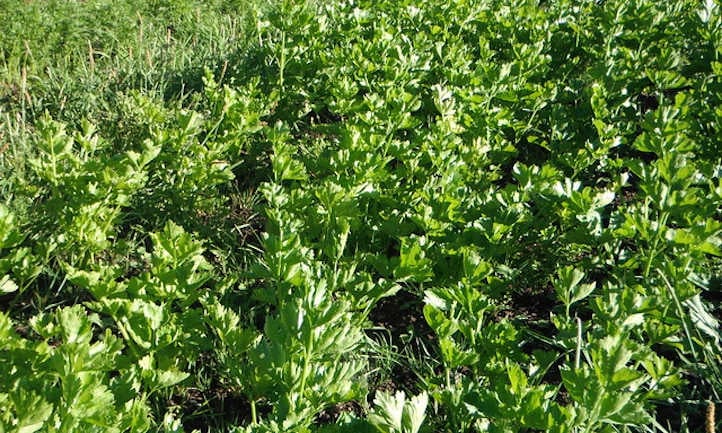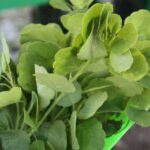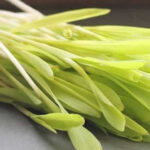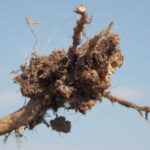Celery can be a difficult plant to start from seed and may frustrate beginner gardeners. However, with a little knowledge and some patience, anyone can learn how to grow celery at home!
Homegrown celery often has a much stronger taste than store-bought celery because commercial growers blanch their celery. This gives the plant a lighter green color and a mild, sweet taste.
Celery has been cultivated in the Mediterranean for thousands of years. Based on archeological digs, celery seed has also been found in Switzerland and China. The plant was used as an herb in Egypt, Rome, and China as a cure for hangovers or as an aphrodisiac, although there is no proof that it worked. The Greeks, Romans, and Egyptians used the leaves of celery to weave crowns for victorious athletes. It wasn’t until the 1600s in France that it was grown for edible purposes.
If you want to learn how to grow this ancient vegetable for yourself, keep reading!
Quick Care Guide
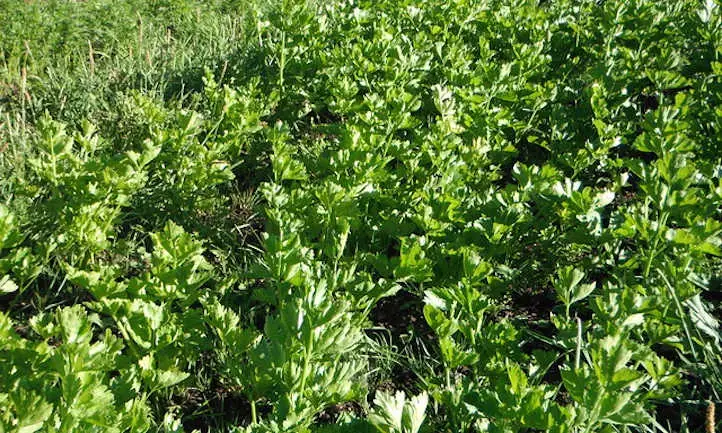
| Common Name(s) | Celery |
| Scientific Name | Apium graveolens |
| Days to Harvest | 90-140 days, depending on the variety |
| Light | Full sun, with afternoon shade |
| Water: | Frequently to maintain consistent moisture |
| Soil | Rich with high fertility, can tolerate wet soil |
| Fertilizer | Regularly with a balanced fertilizer such as 5-10-10 |
| Pests | Aphids, whiteflies, cutworms, cabbage loopers, slugs, snails |
| Diseases | Mosaic viruses, early and late blight, blackheart, fusarium yellows, pink rot |
All About Celery
Apium graveolens is native to the Mediterranean region. It has become a staple vegetable crop not just in the Mediterranean and East Asia, but around the world.
Celery has a compact root system with tall fibrous stalks that taper into leaves. Celery is grown for its stalk and leaves, but its cousin Celeriac is grown for the bulb-like cluster that forms below the stalks.
There are three different kinds of celery: self blanching or yellow celery, green or Pascal celery, and celeriac. Pascal, or green stalk celery, is the most popular kind of celery in the United States.
Of the Pascal varieties, one of the most popular is Tall Utah because it is a crisp, stringless green celery, and is a vigorous grower in many climates. Conquistador is an early maturing variety that can handle heat and moisture stress, as well as less fertile soils.
If you want to try unique colored celery, try Redventure for hearty red stalks, Chinese pink celery for light pink stalks, and Pink Plume Celery for dark purple stalks.
Planting Celery

Start celery 8-12 weeks before frost in temperate areas to make sure it has a full growing season. In warmer climates, it should be planted in the fall and transplanted outdoors when temperatures are consistently below 75 degrees and around 50 degrees at night.
Celery needs full sun but will benefit from afternoon shade. Plant celery in in-ground trenches, garden beds, or self-watering containers.
Start celery seeds on top of a seed-starting potting soil. Celery seeds need light to germinate, so don’t cover seeds with soil. Keep the celery seeds moist by misting the surface of the soil to keep it damp. You can also add a humidity dome to keep the moisture contained. Be patient! Celery can germinate as quickly as one week, but it can also take up to four weeks to grow.
If you are growing celery that is trenched, you should dig trenches about one foot deep to plant in. If you are blanching your celery, you can plant celery at ground level. You can also cover stalks with soil by mounding it up around the plant. Be sure to maintain consistently moist soil so celery can thrive.
Care
Celery is not difficult to grow once you get it started. Now let’s talk about how we can keep your celery plant thriving once you plant it!
Sun and Temperature
Celery is a cool-season crop that should be grown in 6 hours of full sun with afternoon shade. Most varieties of celery can be grown anywhere from Zone 2 to Zone 10.
Celery likes moderate temperatures. It needs weather that is at least 50 degrees and no less than 40 degrees. If the temperatures drop below 40 degrees or rise above 75 degrees, your celery will start to bolt. Anything below 30 degrees will kill your celery.
Make sure you harden your plant off before transplanting into the garden by exposing it to more direct sunlight each day. Set the plants outside two weeks before your last frost. Try to select a variety that grows well in your climate so you can avoid issues with temperature fluctuations.
Celery should always be protected from the hottest part of the day. In cold weather, you may also need to cover it with a row cover or cold frame to protect it.
Water and Humidity
Celery should be watered early in the morning to prevent unnecessary evaporation. Celery has shallow fibrous roots that cannot dry up or the plant will become fibrous and bitter, and it could die. Try to water your celery about 1-2 inches of water per week. This can be done with a soaker hose, drip irrigation, or even a clay olla. The goal is to keep the soil consistently moist.
You can also mulch deeply to keep the soil cool and moist in between watering.
Soil
Celery needs fertile soil to grow well. Start by amending any potting soil with compost or a balanced fertilizer. The soil pH should be between 6.0 and 7.0. Add lots of compost and organic matter as your celery grows to maintain rich soil.
Garden celery should not be planted in a well-draining container. In fact, celery can tolerate poor drainage, and even likes wet soil. Grow celery in a self-watering container so you can fill the water reservoir and spend less time watering!
Fertilizing
Fertilize celery every 10-14 days with a balanced fertilizer, like a 5-10-10. Add compost and organic matter again every two weeks to maintain rich soil.
Since celery has a long growing season, you can use liquid fertilizers like liquid seaweed or worm tea for fast nutrients, or you can use a slow-release feeder that will feed your celery over a longer period of time. Choose organic fertilizer when possible.
Pruning
You do not need to prune your celery. If you are interested in blanching celery, you can tie the stems loosely together to reduce the light that reaches the center stems, which makes the celery plant sweeter and more mild tasting.
Propagation
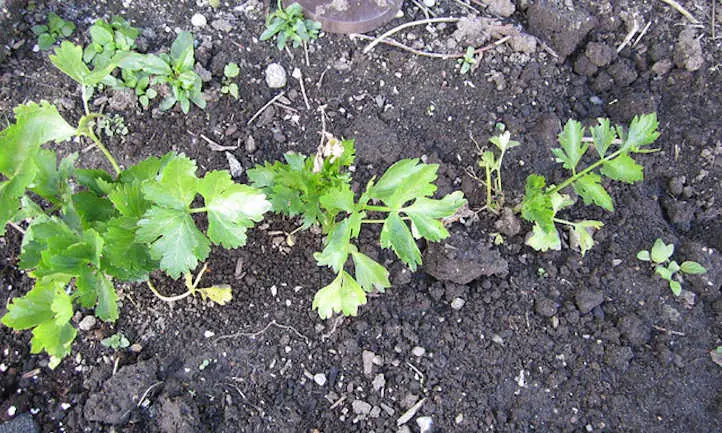
The primary method of propagation for celery is from seed, as described in the planting section above. But you can also try growing celery from store-bought stalks! You will need the roots of the plant, which are usually included in store-bought celery plants.
Cut the celery stalks between 2 inches and 3 inches above the base of the plant. Then, take the base and place it in a shallow dish of water, with the area where you cut the stalks facing up. Celery can’t grow from single stalks. Make sure you change out the water every other day so it stays fresh.
After about a week, tiny green leaves will begin to form in the center of the celery plant. When the roots and leaves sprout, transplant the celery plant into moist and fertile soil so it can keep growing on its own.
Propagating celery from its base is a great way to have celery grow quickly and easily!
Harvesting and Storing
Now, let’s talk about how to harvest celery. Once you’re done growing celery, you’ll need to either use or preserve it for later.
Harvesting
Celery is ready to harvest when the stalks are at least 8 inches tall. You can cut individual celery stalks off with a knife at the base where the stalks join together. This is called “cut and come again” because the celery will sprout and regrow from the base, just like when you are re-growing celery from the store.
You can also harvest individual stalks from the plant as it grows. By harvesting individual stalks, you can allow the plant to produce over a longer season, and you will stagger your harvest to only a few stalks at a time instead of a whole bunch.
As the celery stalks become darker in color, they are more nutrient-dense, but also tougher and more stringy. If you want mild and sweeter tasting celery, be sure to harvest stalks before they darken, or cover them to prevent the plant from getting darker in the sunlight. This is called blanching, and it will create lighter colored celery, similar to what you will find in the local supermarket.
Storing
To keep celery fresh in the refrigerator, wrap the stalks in a moist paper towel and seal them in plastic bags. Celery should last two to four weeks in the fridge if it is properly stored.
For longer storage, you can preserve celery by freezing it. First, you should blanch it by cooking in boiling water for one minute. Once blanched, drop it into an ice water bath to stop the cooking process. Remove it from the water and allow it to dry before storing in a freezer-safe bag and placing in the freezer. This makes a great soup and stock base.
Celery can also be dehydrated or freeze-dried for shelf-stable storage.
Troubleshooting
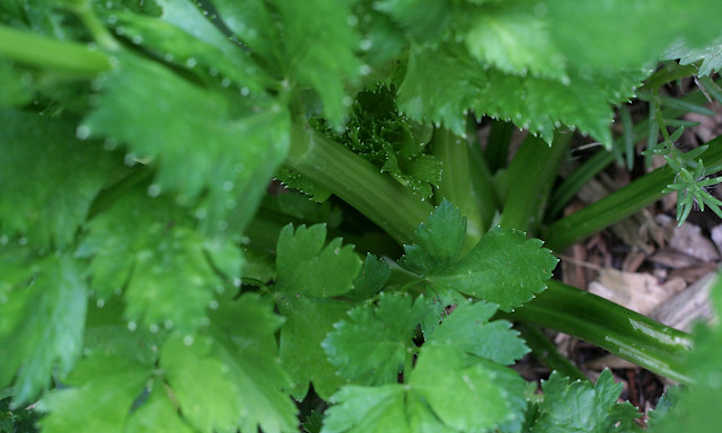
Now, let’s talk about a few common problems you might encounter when growing celery.
Growing Problems
One of the most common problems with growing celery is skinny stalks. The celery plant is mostly water, so if your celery has skinny stalks, it might be a watering issue. Be sure to maintain consistent soil moisture so your plant isn’t thirsty, or else the stalks might not fully develop.
Celery becomes bitter and tough when exposed to sunlight. Most commercial growers prevent this by blanching celery by covering the stalks with soil, paper, cardboard, or another material. Blanching celery will prevent the stalks from becoming bitter.
Celery is susceptible to premature bolting, which is caused by fluctuating temperatures that are either too warm or too cold. Be sure to protect your celery with a cloche, cold frame or floating row covers if a frost is expected, and plant according to your last frost date.
Blackheart is caused by calcium deficiencies and is similar to blossom end rot in tomatoes. As the plant grows, the young stalks and leaves in the heart of the plant will turn black. This is a physiological effect due to the lack of calcium, and can be caused by multiple different things: irregular watering, over-fertilization (particularly with nitrogen or potassium), and high soil salinity may be to blame.
To prevent black heart from forming, ensure your celery has consistent moisture rather than wide fluctuations from wet to dry. Make sure you’re not providing too much fertilizer for your plant. If symptoms start to appear, a soil drench around the plant of water-soluble calcium may help. A foliar spray of calcium to the heart of the plant can also be effective.
Pests
Aphids can destroy your celery by stunting growth and removing the sap. They’re also vectors for many common celery diseases like celery mosaic virus. You can control aphids by blasting them off plants with a hose. If that doesn’t work, you may need to use neem oil or an organic insecticide.
Whiteflies (Trialeurodes vaporariorum) cluster underneath plant leaves and feed on its juices, and that can kill your plant over time. You can blast the whiteflies off with a hose. If that doesn’t work, try neem oil. Finally, you can use products containing pyrethrin, which works well on whiteflies and is safe for many plants.
Cutworms are the caterpillar form of several different kinds of moths and will feed on the stalk and leaves of your celery plant. To control cutworms, you can search the undersides of leaves at night, using a flashlight if necessary. If hand-picking doesn’t work, you can add cardboard or foil collars to your celery plants to prevent the cutworms from getting to the base of the celery plant. Bacillus thurigiensis, or BT, can also be useful against cutworms. Once the celery matures a bit, cutworms are far less of a concern.
Slugs and snails are common pests of celery. They will both strip a plant down to the stalk if left unchecked! The best defense for both is removing by hand. You can also create a barrier of ground oyster shell or sawdust. Organic solutions that use iron phosphate to slow their feeding are also a great option.
Be careful if you choose to use any poisons. The commonly promoted Metaldehyde only kills about 10% of slugs, but also kills the natural and beneficial predators that can help keep the slug population down.
Although cabbage loopers prefer cruciferous plants, they will also attack celery, causing large and irregularly shaped holes. Cabbage loopers can be controlled by handpicking, neem oil, or an insecticide like Spinosad.
Diseases
Cucumber mosaic virus (CMV) and Celery mosaic virus (CeMV) are the most common celery diseases. Leaves and stalks will develop yellow patches and growth is stunted. To stop the problem from spreading, you will need to remove all infected plants.
Blight (both early blight caused by cercospora or late blight caused by septoria) develops as small yellow dots on both sides of the leaves. Spots will get larger and change color. Most commercial fungicides work against blight, including biofungicidal sprays and copper-based fungicides. Neem oil may also be effective as a preventative.
Celery is not immune to fusarium fungi, alas. Fusarium yellows results when Fusarium oxysporium is lingering in the soil. It causes stunted, yellow plants and can cause rot in and around the base and root system. The best method to control it is to prevent the fusarium from becoming established in your soil. Plants that are impacted should be removed, and only resistant cultivars or plants that are not impacted by fusarium should be planted in that soil. A mycofungicide may help reduce fusarium contamination.
Pink rot caused by Sclerotinia sclerotiotum is another fungal issue for celery. The base of the stalks will develop brown lesions with pink margins, and over time the entire stalk may turn brown and collapse. Like fusarium, it can linger in the soil for long periods of time. Unlike fusarium, this usually appears in soils that have been over-saturated with water for at least a couple weeks’ time or longer, so maintaining good watering practices is the key to prevention. Make sure your soil drains excess water well so the celery isn’t in constantly-soggy conditions.
Frequently Asked Questions

Q: How do you harvest celery so it keeps growing?
A: Harvest only a few stalks at a time, and the plant will keep producing new growth all season!
Q: Can you eat celery leaves?
A: Yes, they are nutritious and often have a stronger flavor than the stalk.
Q: What can you not plant near celery?
A: Don’t plant celery near anything that will compete for nutrients, like carrots, corn, or potatoes. Avoid carrots and parsley because they have similar predators and may cause an invasion.

